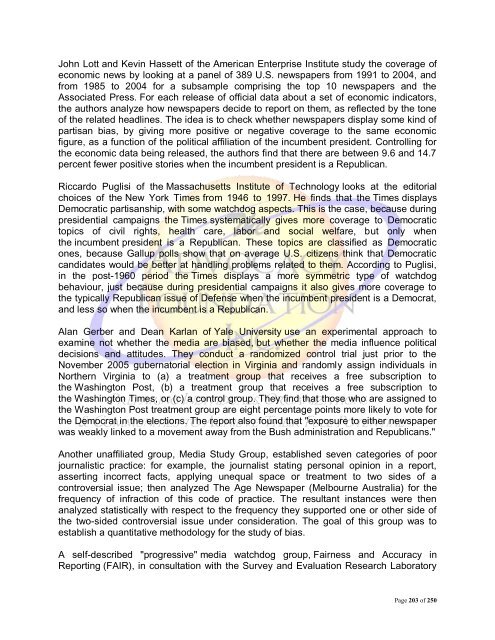Institutional Racism
Institutional Racism
Institutional Racism
You also want an ePaper? Increase the reach of your titles
YUMPU automatically turns print PDFs into web optimized ePapers that Google loves.
John Lott and Kevin Hassett of the American Enterprise Institute study the coverage of<br />
economic news by looking at a panel of 389 U.S. newspapers from 1991 to 2004, and<br />
from 1985 to 2004 for a subsample comprising the top 10 newspapers and the<br />
Associated Press. For each release of official data about a set of economic indicators,<br />
the authors analyze how newspapers decide to report on them, as reflected by the tone<br />
of the related headlines. The idea is to check whether newspapers display some kind of<br />
partisan bias, by giving more positive or negative coverage to the same economic<br />
figure, as a function of the political affiliation of the incumbent president. Controlling for<br />
the economic data being released, the authors find that there are between 9.6 and 14.7<br />
percent fewer positive stories when the incumbent president is a Republican.<br />
Riccardo Puglisi of the Massachusetts Institute of Technology looks at the editorial<br />
choices of the New York Times from 1946 to 1997. He finds that the Times displays<br />
Democratic partisanship, with some watchdog aspects. This is the case, because during<br />
presidential campaigns the Times systematically gives more coverage to Democratic<br />
topics of civil rights, health care, labor and social welfare, but only when<br />
the incumbent president is a Republican. These topics are classified as Democratic<br />
ones, because Gallup polls show that on average U.S. citizens think that Democratic<br />
candidates would be better at handling problems related to them. According to Puglisi,<br />
in the post-1960 period the Times displays a more symmetric type of watchdog<br />
behaviour, just because during presidential campaigns it also gives more coverage to<br />
the typically Republican issue of Defense when the incumbent president is a Democrat,<br />
and less so when the incumbent is a Republican.<br />
Alan Gerber and Dean Karlan of Yale University use an experimental approach to<br />
examine not whether the media are biased, but whether the media influence political<br />
decisions and attitudes. They conduct a randomized control trial just prior to the<br />
November 2005 gubernatorial election in Virginia and randomly assign individuals in<br />
Northern Virginia to (a) a treatment group that receives a free subscription to<br />
the Washington Post, (b) a treatment group that receives a free subscription to<br />
the Washington Times, or (c) a control group. They find that those who are assigned to<br />
the Washington Post treatment group are eight percentage points more likely to vote for<br />
the Democrat in the elections. The report also found that "exposure to either newspaper<br />
was weakly linked to a movement away from the Bush administration and Republicans."<br />
Another unaffiliated group, Media Study Group, established seven categories of poor<br />
journalistic practice: for example, the journalist stating personal opinion in a report,<br />
asserting incorrect facts, applying unequal space or treatment to two sides of a<br />
controversial issue; then analyzed The Age Newspaper (Melbourne Australia) for the<br />
frequency of infraction of this code of practice. The resultant instances were then<br />
analyzed statistically with respect to the frequency they supported one or other side of<br />
the two-sided controversial issue under consideration. The goal of this group was to<br />
establish a quantitative methodology for the study of bias.<br />
A self-described "progressive" media watchdog group, Fairness and Accuracy in<br />
Reporting (FAIR), in consultation with the Survey and Evaluation Research Laboratory<br />
Page 203 of 250

















